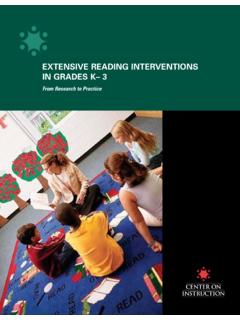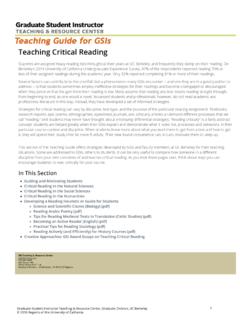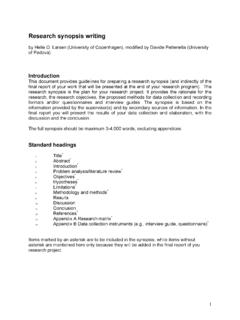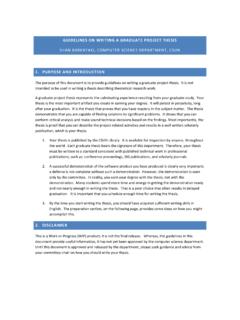Transcription of Thesis Proposal Of Dhammaeeha Pali-5.06updated
1 1 A synopsis OF THE research PROJECT The Thesis Proposal for the Master of Philosophy research Degree, The School of History, Philosophy, Religion, and Classics - Centre for Buddhist Studies, University of Queensland. Applicant: Ven. Udagama Dhammaseeha Thero Topic: An Annotated Translation of pamma Vagga Commentary (Papa ca S dan ) of Middle Length Discourse (Majjhima Nik ya), together with a Comprehensive Introduction. Introduction Papa cha S dan (hereafter-PS) is the commentary on the Majjhima Nik ya (hereafter-MN). It was composed in the early 5th century by the great Buddhist commentator, cariya Buddhagh sa at the request of Buddhamitta. PS is based on the ancient commentaries which no longer exit, that had been preserved for centuries by the Sangha of the Mah vih ra at Anur dhapura, Sri Lanka. The commentaries provide exposition of the meaning of the text as well as the background to the events that led to the promulgation of the discourses.
2 MN has three volumes and each has fifty Suttas or discourses with the exception of twelve Vibh aga (expositions). These discourses are grouped under 15 Vaggas. Each Vagga contains ten Suttas. The pamma Vagga (Section of Parables) is the third among fifteen Vaggas. PS gives detailed exposition and background to the discourses of this Vagga. They are as follows: 1. Kakac pama Sutta Va an 6. Ariyapariyesana Sutta Va an 2. Alagadd pama Sutta Va an 7. C lahathipad pama Sutta Va an 3. Vammika Sutta Va an 8. Mah hatthipad pama Sutta Va an 4. Rathav nita Sutta Va an 9. Mah s r pama Sutta Va an 5. Niv pa Sutta Va an 10. C las r pama Sutta Va an 2 In my research , I will be providing an elaborated introduction and an annotated translation to the commentarial exposition of these Suttas. Significance and the background to the study The scholars, who have previously studied the P li Canon, and translated the discourses paid little attention to its commentaries and sub commentaries.
3 In the available translations of commentaries a large section of the valuable teachings of the Buddha have not been given adequate attention. Furthermore, there appear to be certain misinterpretation of passages. Difficult words and abstruse points of the discourses that occur in the P li Canon cannot be sufficiently supported without due reference to their P li commentaries. P li commentaries preserve the earliest interpretation of the texts. Though P li commentaries were properly documented in the 5th century , the interpretation and exposition of the texts are based on a much earlier tradition of interpretation that was common to Therav da School. As such the available interpretation belongs to a quite close period of the original texts of the Suttas. Therefore, P li commentaries provide a source to make them understand how the early scholars had interpreted the texts of the P li canon.
4 It seems P li commentaries, expositions and their interpretations provide a background to the context and the cultural side of the discourses. The words and terms often get their meanings in the relevant cultural context. In comprehending a Sutta, knowledge of its context and cultural background is vital to grasp the meaning and relationship of the discourses. P li commentaries have been able to interpret the Suttas in their natural contexts and provide a background to the students who follow the P li canon. 3 The knowledge I aim to harness from the Thesis , is expected to generate a wide perspective of the modern reading of the P li canon in the selected middle length discourse. The outcome of the Thesis is expected to lift the barriers that inhibit comprehensive understanding of the discourses, and make available translations to facilitate the reading of the discourses alongside their commentaries.
5 Scope and Methodology of research The main objective of my study is to present a comprehensive translation of pamma Vagga of Papa ca S dan . Since there has been no previous English translation of the commentarial exposition of pamma Vagga, I will be providing an English translation of this section of the middle length discourses The translation would be complemented by annotations. Whenever necessary, grammatical explanations would be given with detailed meaning as originally intended by the commentator. In addition, without due references to sub commentaries, a reader may not be able to achieve a proper understanding of passages in the original text. So, I shall refer to relevant passages of the aforesaid sub-commentaries wherever necessary. The texts which shall be used for this translation is taken partially from the edition of the P li Text Society, London, with a few changes based on the Sinhalese editions.
6 For this purpose, the relevant portions of the two editions of MN would be consulted in order to determine the most appropriate readings. In my general introduction, I propose to discuss the importance of the original text as a commentary on the Sutta Pitaka. 4 Sources to be used Primary: 1. B dhi, Bhikkhu, The Middle Length Discourses of the Buddha, Kandy, Buddhist Publication Society, 1995. 2. B dhi, Bhikkhu, The Connected Discourses of the Buddha, Kandy, Buddhist Publication Society, 2000. 3. Woods, , and Kosambi. D., Majjhima Nik ya hakatha, The P li Text Society, Text series No. 82, 1979. 4. The commentary on the Majjhima Nik ya (Papa ca S dan ) (Sinhala Script Edition), The Tripitake Publication Press, Colombo, Vol. 35, 1933. Secondary: 5. Masefeild, Peter. The Ud na Commentary, Oxford, P li Text Society, 2001. 6. B dhi, Bhikkhu.
7 The Mah nid na Sutta and its Commentaries, Kandy, Buddhist Publication Society, 2000. 7. B dhi, Bhikkhu. The Brahmaj la Sutta and its Commentaries, Kandy, Buddhist Publication Society, 1978. 8. Collins, Steven. Agga a Sutta An Annotated Translation, Delhi, Swastik Offset Printers 2001. 9. Malalasekera , Dictionary of P li Proper Names, Munshiram Manoharlal Publishers, 2002. 10. Anuruddha Mah Thero, Kakkapalliye. P li Dictionary of Idioms, Hong Kong, Chi Lin Nunnery, 2004. 11. Buddhadatta Mah Thero, Pollwatte. Pali-Sinhala Dictionary, Colombo, Buddhist Cultural Centre, 1998. 12. Davids, Rhys , Stede, William. P li-English Dictionary, New Delhi, Munshiram Manoharlal Publishers, 2001.









